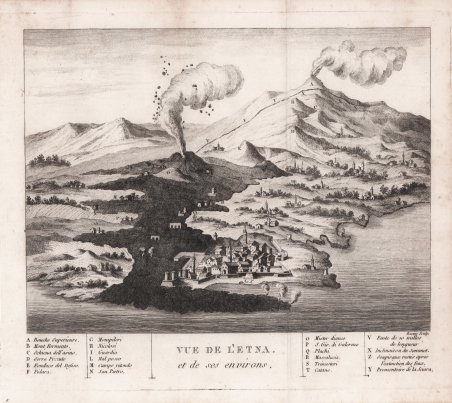Veduta tratta dal celebre Voyages Dans Les Deux Siciles Et Dans Quelques Parties Des Apennins, Par Spallanzani, Professeur d'Histoire naturelle dans l'université de Pavie. Traduits e l'Italien par G. Toscan, Bibliothécaire du Museum national d'Histoire naturelle de Paris, avec des Notes du cit. Faujas-de-St.-Fond. A Paris, Chez Maradan, Libraire, rue Pavée-André-des-Arcs, n°. 16. An VIII. 1799 di Lazzaro Spallanzani. Traduzione francese dell’opera stampata per la prima volta nel 1795 a Berna, contiene una variante delle 7 tavole raffiguranti le Isole Eolie e l’Etna che erano state incise da L. Anderloni. Lazzaro Spallanzani (1729-1799) è stato un naturalista, biologo e fisiologo italiano che ha dato importanti contributi allo studio sperimentale delle funzioni corporee, della riproduzione animale, nonché alla geologia e alla vulcanologia. Nel 1754, all'età di 25 anni, divenne professore di logica, metafisica e greco all'Università di Reggio. Nel 1762 fu ordinato sacerdote e nel 1763 si trasferì a Modena. Nel 1769 divenne titolare della cattedra di Storia naturale all'Università di Pavia. ' Spallanzani divenne anche direttore del museo dell'Università di Pavia, dove ampliò notevolmente le collezioni con esemplari raccolti durante i suoi numerosi viaggi nella regione mediterranea. Nel giugno 1768 Spallanzani fu eletto Fellow della Royal Society e nel 1775 fu eletto membro straniero della Royal Swedish Academy of Sciences. Nei sei volumi dei Voyages dans les Deux Siciles, Lazzaro Spallanzani offre un contributo fondamentale allo sviluppo della scienza vulcanologica. Le sue indagini sono state condotte sui vulcani attivi dell'Italia meridionale (in particolare nelle Isole Eolie, sull'Etna e sul Vesuvio). Oltre a contribuire allo sviluppo della teoria del vulcanismo, interpreta il processo di formazione della pomice. Descrive i processi del vulcanismo, l'attività sismica associata, la mineralogia e le rocce associate ai vulcani ed è stato il primo ad applicare metodi sperimentali per descrivere la formazione della pomice e di altre rocce e minerali. Acquaforte, in buono stato di conservazione. View taken from Voyages Dans Les Deux Siciles Et Dans Quelques Parties Des Apennins, Par Spallanzani, Professeur d'Histoire naturelle dans l'université de Pavie. Traduits e l'Italien par G. Toscan, Bibliothécaire du Museum national d'Histoire naturelle de Paris, avec des Notes du cit. Faujas-de-St.-Fond. A Paris, Chez Maradan, Libraire, rue Pavée-André-des-Arcs, n°. 16. An VIII. 1799. French translation of the work first printed in 1795 in Bern, contains a variant of the 7 plates depicting the Aeolian Islands and Etna that were engraved by L. Anderloni. Lazzaro Spallanzani (1729 –1799) was an Italian naturalistt, biologist and physiologist who made important contributions to the experimental study of bodily functions, animal reproduction, as well as to geology and volcanology. In 1754, at the age of 25, he became professor of logic, metaphysics snd Greek in the University of Reggio. In 1762 he was ordained as a priest, and in 1763 moved to Modena. He became the Chair of the Natural History Department at the University of Pavia in 1769. ' Spallanzani also became director of the museum at the University of Pavia, where he greatly expanded the collections with specimens collected during his many travels in the Mediterranean region. In June 1768 Spallanzani was elected a Fellow of the Royal Society, and in 1775 was elected a foreign member of the Royal Swedish Academy of Sciences. In the six volumes of the Voyages dans les Deux Siciles, Lazzaro Spallanzani offers a major contribution to the ' development of the science of volcanology. His surveys were carried out on active volcanos of southern Italy (in particular in the Aeolian Islands and on Mt. Etna and Vesuvius).In addition to contributing to the development of the theory of volcanism, he interprets the process of formation of pumice. He describes the processes of volcanism, the associated seismic activity, and the mineralogy and rocks associated with the volcanoes and was the first to apply experimental methods to describe the formation of pumice and other rocks and minerals. Etching, some foxing, otherwise good condition. Cfr.

Scopri come utilizzare
Scopri come utilizzare

